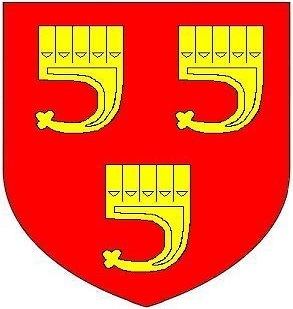Name John 1st | ||
 | ||
Died August 22, 1701, London, United Kingdom | ||
John Granville, 1st Earl of Bath PC (29 August 1628 – 22 August 1701), of Stowe in the parish of Kilkhampton in Cornwall, was an English Royalist soldier and statesman during the Civil War who played a major role in the 1660 Restoration of the Monarchy and was later appointed Lord Lieutenant of Ireland. He was the first in his family to adopt the modernised spelling as Granville of their ancient surname Grenville, which emphasised their supposed ancient 11th-century origin from the Normandy manor of Granville, Manche.
Contents
Origins
He was the eldest son and heir of Sir Bevil Grenville (1596-1643) lord of the manors of Bideford in Devon and Stowe, Kilkhampton in Cornwall, a Royalist soldier killed in action in heroic circumstances at the Battle of Lansdowne in 1643 during the Civil War. Sir Bevil served as MP for Cornwall 1621–1625 and 1640–42, and for Launceston 1625–1629 and 1640. John's mother was Grace Smythe, a daughter by his second marriage of Sir George Smith (d.1619) of Madworthy, near Exeter, Devon, a merchant who served as MP for Exeter in 1604, was three times Mayor of Exeter and was Exeter's richest citizen, possessing 25 manors or part manors. John had thirteen siblings, all by Royal Warrant of Precedence granted the rank and title of Earl's children by King Charles II on 20 August 1675, in recognition of their father's services. Grace's half-sister Elizabeth Smythe was the wife of Sir Thomas Monk (1570–1627) of Potheridge, Devon, MP for Camelford in 1626, and mother of the great General George Monck, Duke of Albemarle, KG (1608-1670), the main figure behind the Restoration of the Monarchy in 1660. It was largely due to his close kinship to his first cousin the Duke that Sir John Grenville was raised to the peerage in 1660 as Earl of Bath and was also granted the reversion of the Duchy of Albemarle in the event of the failure of George Monck's male issue.
Career
Granville fought in the English Civil War in his father's regiment on the side of the defeated King Charles I (1625-1649). He was created a knight due to his bravery, and became a Gentleman of the Bedchamber to Prince Siarl II of Wales, later King Charles II of England (1660-1685).
He accompanied the future King Charles II into exile, and mediated with the Long Parliament. After the Scilly Isles rebelled against the Parliamentary government in 1648, he was sent by Charles II to be the Governor of the Scilly Isles in place of the Parliamentarian Governor Anthony Buller. Under his governorship, the Scilly Isles became a base for Royalist privateers attacking both English and Dutch vessels in the Western Approaches and in May 1651 he was ousted by Parliamentary forces under Robert Blake.
In 1660, Granville was instrumental in the negotiations between his first cousin George Monck, and Charles II that led to the Restoration of the Monarchy to that King. Shortly after the Restoration, he contested the succession of the Duchy of Albemarle, but lost. On 20 April 1661 he was created by King Charles II Baron Granville, Viscount Granville and Earl of Bath and in 1663 was invested as a Privy Councillor. In 1665, he served, in title at least, as Lord Lieutenant of Ireland, although he never went to Ireland and consequently is not considered a true holder of that office. In about 1680, he rebuilt his ancestral seat of Stowe House in Cornwall in a grand style befitting his new noble status. His cousin the Duke of Albemarle between 1660 and his death in 1670, had commenced rebuilding on a similarly grand scale of his own ancestral seat of Potheridge in Devon, about 18 miles to the east of Stowe. Both new mansions were demolished within a few decades.
Lord Bath was twice appointed colonel of the Earl of Bath's Regiment (later the 10th Regiment of Foot), first in 1685 then again in 1688 at around the time of the Glorious Revolution.
Marriage and progeny
In October 1652 at Kilkhampton John Granville married Jane Wyche, a daughter of Sir Peter Wyche, English ambassador to the Ottoman Empire. By his wife, he had five children:
Sons
Daughters
Death
He died in London in 1701.
Armorials
The armorials of the family of Granville / Grenville of Glamorgan, Devon and Cornwall is of certain form but uncertain blazon. The charges appear in the form of musical pipes of a wind-instrument, similar to pan-pipes. Authoritative sources on heraldry suggest the charges to be variously "clarions" (used by Guillim (d.1621)), the most usual blazon, which are however generally defined as a form of trumpet; "rests" is another common blazon, denoting lance-rests supposedly used by a mounted knight; "organ-rests" is also met with, a seemingly meaningless term (Gibbon (1682)). Other terms are "clavicymbal", "clarichord" and "sufflue" (used by Leigh in his Armory of 1562 and by Boswell, 1572), the latter being a device for blowing (French: souffler) air into an organ., Guillim suggested the charge may be a rudder, but in which case it is shown upside down, when compared to that charge used for example on the tomb at Callington of Robert Willoughby, 1st Baron Willoughby de Broke. Certainly in the brasses on the chest tomb of Sir John Bassett (d.1529) in Atherington Church, Devon, the charges are engraved in tubular forms with vents or reeds as used in true organ pipes.
